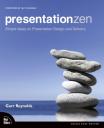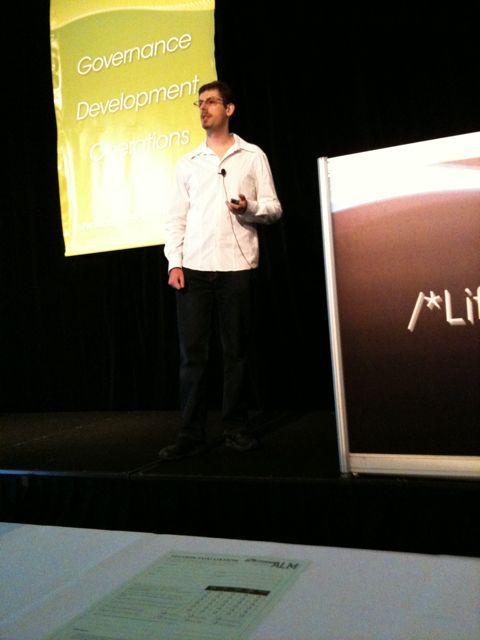Thanks everyone who came along last night. It was a fun session, with a lot of lively discussion, especially around project management and software design. As mentioned during the talk, you might want to check out nRake for .NET builds and psDeploy for Powershell deployments. Here are the slides from the talk. If you have any more questions or areas to discuss, please feel free to drop me a line.
Category: Talks Page 2 of 4
I’ll be giving a presentation at an Australian Computer Society Special Interest Group on Wed 2 June, 6:30pm. More details here.
The abstract is:
Application Lifecycle Management (ALM) covers the whole software development lifecycle and associated processes including project management, business analysis, testing, build and deploy and development. Based on experiences in the field on projects with ThoughtWorks and consulting with other teams, I will describe what I consider to be the ultimate ALM environment, using an agile approach and techniques. This talk will cover goals, assessment criteria, practices, tools, and physical workspace design.
Hope to see you there!
The inaugural Australian ALM Conference has been an interesting 2 days. The first day had a number of insightful talks, especially interesting to hear Sam Guckenheimer on how Microsoft has been reshaping their internal development practices into a more agile model. Today, I enjoyed Richard‘s agile adoption talk (hear hear!) and the other highlight was the last presentation of the day, explaining what’s gone into the design of the new Windows 7 Mobile OS (though some things still seem under wraps). Also a pleasure to catch up with some old friends at the conference.
Conference organisation was very good (thanks to Anthony Borton and his team). The focus was very Microsoft centric, but next year, the plans are for a much wider variety of content. Lunar Park was a cosy conference venue and fun to go outside during the breaks and see kids screaming on rides and the sun shining on the bridge and harbour.
My presentation was 8.30am this morning (aargh!) but despite the early hour, there was a reasonable turn out and quite a few interested people asking questions. The plan was to co-present with Jason Yip, but he was called away to Perth so I presented solo. Unlike most other presentations at the conference, Visual Studio and TFS were barely mentioned. Instead I focused on current problems in each area of ALM, coming up with a criteria to assess this area, and what we usually do on projects to meet this criteria – eg, story walls, story maps, automated build and deploy etc. You can find the Powerpoint slides here. The slides are promises for a conversation (ie, mainly images with some notes), so don’t hesitate to contact me if you want to chat.
Also, thanks Richard for this photo from the presentation:
Jason Yip and I will be presenting on “The ultimate (circa 2010) ALM environment” at the Australian ALM Conference on 14 April. We’ll be talking about using agile methods and tools for ALM, rather than a vendor suite.
Here’s the blurb:
Based on our experiences in the field on projects and consulting with other teams, we will describe what we consider to be the ultimate development environment (which is not just about vendor tools). This session will discuss principles, practices, tools, and physical workspace design.
Hope to see you there!
 After being impressed by Garr Reynolds speaking in Sydney a year or so ago, I’ve been keen to check out his Presentation Zen book. It is an enlightening read, especially if you have never studied art or graphics design. The book is a little over 200 pages long, with many illustrations and a impressive, clean layout (no surprise there!).
After being impressed by Garr Reynolds speaking in Sydney a year or so ago, I’ve been keen to check out his Presentation Zen book. It is an enlightening read, especially if you have never studied art or graphics design. The book is a little over 200 pages long, with many illustrations and a impressive, clean layout (no surprise there!).
Near the start of the book, Garr talks about creativity requiring an open mind (child like) and a willingness to be wrong, and to experiment. He recommends exercising restraint, and focusing on simplicity, clarity and brevity. He starts presentations brainstorming using pen and paper, whiteboards or post-its rather than in front of the computer (personally I often use story cards as you can jot slide outlines on them, group, and shift the order around). He recommends grouping the ideas, and identifying the core message and sticking with that message throughout the whole presentation.
Garr highlights the importance of taking the time to slow down and really think about what to put in the presentation. He suggests that you keep two important questions in mind: “What’s your point?” (what one thing do you want the audience to remember), and “Why does it matter?” (put yourself in the audiences’ shoes). If bits of your content don’t aid in answering these questions, “when in doubt, cut it out”! Garr also suggests an “Elevator test” – can you make your pitch in 30-45 seconds? A structure that works well is starting with an introduction which explains the issue (the pain) and the core message. Then something like 3 parts that support your assertions or solve the pain (sounds a bit like Bosworth’s Solution Selling).
“Amplification through simplification” is central to Garr’s design approach. He advocates lots of empty space to highlight just one or a few important elements on a slide. “Simplicity can be obtained through the careful reduction of the non-essential” and decreasing the signal vs noise ratio of the slides. Garr is a big fan of using images on slides with just a few words. The aim is to make slides which have strong, memorable impact, and enhance the presenter’s spoken words. He also highlights the importance of having the audience know where to look. Eg, simplicity plus images leading the eye to the right spot (eg, people in images on the slide look towards the words on the slide). Garr is a big fan of using quotes to support his points.
Garr suggests a mix of symmetrical and asymmetrical slides. Symmetrical are more formal and static, where as asymmetrical slides are often more dynamic and interesting and activate empty space. He also suggests using a grid, such as the rule of thirds (2 horizontal and 2 vertical lines providing a grid of 9 equally sized boxes), with the main subject placed on one of the crossing points of the lines. Contrast (using colour, shape, space, etc) can be used to make an element stand out and helps the viewer “get” the point of the design quickly. Repetition can be used (eg, text on each slide in an image of a post-it) to provide a professional and unified look. Use proximity to group related objects.
Although Garr doesn’t talk about it explicity, his sample slides tend to make use of clever typography. Often lower case text, with most important part in a bigger font. A mix of colours and sizes and styles and sometimes rotations to add interest to the slides. Generally sans-serif fonts.
On presenting itself, Garr says you should be completely present – enthusiastic and completely focused on presentation that you are giving, lost in the moment. Nothing else. Although you may make mistakes, don’t dwell on them. Practice like mad to become confident and appear easy and natural for the presentation. However, remain flexible, aware and open to possibilities as they arise (being “in the moment”).
Near the end of the book, Garr says: “It’s not about us [the presenter], it’s about them. And about the message.”. He also suggests that shorter is better, leave the audience wanting more, not overloaded (as per Japanese proverb “eat until 80% full”). On delivery, Garr suggests standing front and centre, leaving the lights on and advancing slides with a remote.
Garr’s points are much more clearly illustrated using images in the book. I would recommend Presentation Zen to anyone who is interested in making more visually inspiring and interesting presentations.
Here are the slides and code from yesterday’s talk at Sydney ALT.NET.
See Steve Sanderson’s post for the code/binary for subclassed aspx compiler and more information about the automatic encoding approach we covered in the talk.
I’ll be giving a lightning talk on securing your ASP.NET MVC site against code injection and x-site scripting next Tuesday 25 August at the Sydney ALT.NET group. I’ll be demonstrating potential pitfalls and dangers of arbitary code injection, and how you can protect against it, elegantly. We’ve got 6 interesting talks lined up for the night. See you there!
Thanks very much to Nigel for inviting me to present on REST at St George Bank in Kogarah, and to ThoughtWorks for the time in the middle of the day to give the talk. It was a fun session and the people attending asked quite a number of good questions. Here are the slides. Please note that they are about 10mb (thanks to all the images). There’s some extra information in the “Notes” pane as well.
This evening we had the first Sydney Alt.Net meeting. It went really well. Our venue at the ThoughtWorks offices was pretty packed with about 35 interested people coming along. We started with a discussion of news in the .NET space, and then broke for food. After that we had my presentation on Ruby & Rails from a .NET perspective, followed by Richard’s presentation on Rhino Mocks. We ended with a retrospective to gather feedback and thoughts for future meetings. Thanks to everyone for coming along and making it such a great night! And also a big thank you to ThoughtWorks for the venue, food and drink.
Here’s the slides from “Ruby and Rails from a .NET perspective”. It’s a bit hard to give you a transcript of the demos but here is a taste of some of the ruby commands we looked at today.
Basic IronRuby Console demo
4+4
"hello".class
$friends = ["James", "Richard", "Bill"]
$friends.find_all { |f| f.include? "a" }
$friends.collect { |f| f.length }
"-" * 100
$person_type = Struct.new(:name, :age, :sex)
$j = person_type.new("James", 27, "m")
Iron Ruby Calling WinForms
require 'System.Windows.Forms, Version=2.0.0.0, Culture=neutral, PublicKeyToken=b77a5c561934e089' Form = System::Windows::Forms::Form MessageBox = System::Windows::Forms::MessageBox Button = System::Windows::Forms::Button $b = Button.new $b.text = "Hello Button" $f = Form.new $f.controls << $b $f.show_dialog
Simple Rails App Demo
rails myapp ruby script/generate scaffold Person name:string age:integer rake db:migrate ruby script/server

